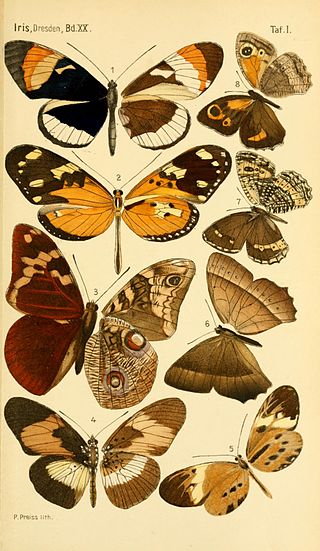Related Research Articles

Franz Josef Gerstner was a German-Bohemian physicist, astronomer and engineer.

Friedrich Hermann Loew was a German entomologist who specialised in the study of Diptera, an order of insects including flies, mosquitoes, gnats and midges. He described many world species and was the first specialist to work on the Diptera of the United States.

Franz Xaver Kugler was a German chemist, mathematician, Assyriologist, and Jesuit priest.

Ferdinand Ochsenheimer was a German actor and entomologist (lepidopterist).

The poplar admiral is a butterfly in the Limenitidine clade of the family Nymphalidae.
Hans Ferdinand Emil Julius Stichel was a German railways officer and amateur entomologist who specialised in Lepidoptera. His son Wolfgang Stichel became an entomologist who specialised in the bugs.

Carl Heinrich Michael Ribbe was a German explorer and entomologist.

Ludwig Georg Courvoisier was a surgeon from Basel, Switzerland. He was one of the first doctors to remove gallstones from the common bile duct.

Gustav Weymer (1833–1914) was a German entomologist. He described many new taxa of butterflies from specimens collected by Alphons Stübel in South America.

Empis is a genus of dance fly found in the fly family Empididae.
Max Gaede was a German engineer and entomologist of international fame who described several hundred of new species of Lepidoptera, mainly African Noctuidae.

Mark Lidzbarski was a Polish philologist, Semiticist and translator of Mandaean texts.
Heinrich Michael Neustetter was an Austrian entomologist who specialised in Lepidoptera. He was an insect specimen dealer. His collection is held by Naturhistorisches Museum, Vienna.
Ennodius orientalis is a species of leaf beetle of East Africa and the Democratic Republic of the Congo. It was first described by Heinrich Kuntzen in 1912.
Adolph Speyer was a German entomologist who specialised in Lepidoptera, especially Hesperiidae.

Christian Ernst Weiss was a German mineralogist, geologist and palaeontologist. He is not to be confused with the historian Christian Ernst Weiße (1766–1832).

Fritz Netolitzky was a German botanist and entomologist who specialised in Coleoptera. He described many new species. Fritz Netolitzky was born in Zwickau on 1 October 1875 into a respected family who had lived in Rokitnitz since the early 18th century. His grandfather taught him natural history and Fritz Netolitzky went on to study in Prague, Vienna and Strasbourg. Aged 24 he gained a Ph.D. in medicine. Following this he served as a Kaiserjäger for one year and he also served as a doctor on a ‘Kosmos-Linie’ ship registered in Hamburg, a journey which took him along the South American west coast. Fritz Netolitzky taught at the University of Vienna (1896-1899), then at the University of Innsbruck (1899-1904) then at the University of Graz (1904-1910). From 1910 to 1940 he taught at the University of Chernivtsi.From 1940 to 1941 he worked at the University of Iasi, then he was Professor of Botany at the University of Vienna. With his sister Magdalena and brother, Richard, Fritz Netolitzky wrote a parody of Heinrich Hoffman's Struwwelpeter set in Egypt- The Egyptian Struwwelpeter (London: H. Grevel & Co., [1896]

Adolph Schenck was a German entomologist and teacher.

Rudolf Emil Mell was a German zoologist and entomologist who specialised in Lepidoptera especially Sphingidae and the fauna of China. He was the director of the German-Chinese Middle School at Canton (Guangzhou) for some time. His collection of Sphingidae is held by the Carnegie Museum of Natural History in Pittsburgh. It was purchased by Benjamin Preston Clark.
Ennodius is a genus of leaf beetles in the subfamily Eumolpinae. It is known from Africa.
References
- ↑ Fassl, A.H. (1921). "In eigener Sache!". Entomologische Zeitschrift. 35: 106.
- ↑ Seitz, A. (1922). "A. H. Fassl †" (PDF). Entomologische Rundschau. 39: 45.
- ↑ Taut, K. (1923). "A. H. Fassl †" (PDF). Entomologische Zeitschrift. 36: 59–60.